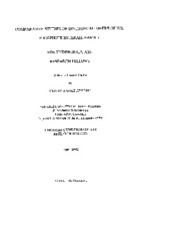| dc.creator | Arriens, Cristina Gale | |
| dc.date.accessioned | 2013-02-22T20:41:44Z | |
| dc.date.available | 2013-02-22T20:41:44Z | |
| dc.date.created | 2002 | |
| dc.date.issued | 2013-02-22 | |
| dc.identifier.uri | https://hdl.handle.net/1969.1/ETD-TAMU-2002-Fellows-Thesis-A762 | |
| dc.description | Due to the character of the original source materials and the nature of batch digitization, quality control issues may be present in this document. Please report any quality issues you encounter to digital@library.tamu.edu, referencing the URI of the item. | en |
| dc.description | Includes bibliographical references (leaf 23). | en |
| dc.description.abstract | Some genes direct the synthesis of specific proteins called enzymes that catalyze specific types of chemical reactions. The class of enzyme of interest in this research, the hydrolases, catalyzes the conversion of functional groups to water. The phosphotriesterase (PTE) family is a subgroup of hydrolases that breaks down organophosphate compounds (OPs). Many organophosphate compounds are potent cholinesterase inhibitors, accounting for their widespread use as insecticides and nerve agents. Enzymes have been found in bacteria and higher organisms that specifically breakdown OPs. One of these enzymes, human serum paraoxonase/arylesterase (PON1), is a calcium-dependent, HDL (High Density Lipoprotein) -associated protein that appears to have multiple roles in vivo. In one guise, PON1 hydrolyses organophosphate insecticides and nerve gases and is responsible for determining the selective toxicity of these compounds in mammals. Using the sequence available in NCBI Genebank, primers flanking the coding region of PON1 were designed and used to screen a human liver cDNA library using polymerase chain reaction (PCR). A single band corresponding to the approximate size of PON1, 1kb, was amplified and subsequently cloned. The identity of the cloned region as PON1 was verified by sequencing using PON1 specific primers, and then cloned into a plasmid named pTYB1 from the IMPACT-CN expression system. Expression was obtained using the BL21-star bacterial strain. The enzyme was found within an inclusion body, and solubilized with urea and DTT. Preliminary activity studies were unsuccessful, so further manipulation of the insoluble fraction is necessary to obtain proper folding. | en |
| dc.format.medium | electronic | en |
| dc.format.mimetype | application/pdf | |
| dc.language.iso | en_US | |
| dc.publisher | Texas A&M University | |
| dc.rights | This thesis was part of a retrospective digitization project authorized by the Texas A&M University Libraries in 2008. Copyright remains vested with the author(s). It is the user's responsibility to secure permission from the copyright holder(s) for re-use of the work beyond the provision of Fair Use. | en |
| dc.subject | life sciences I. | en |
| dc.subject | Major life sciences I. | en |
| dc.title | Comparative studies of diverged members of the phosphotriesterase family | en |
| thesis.degree.department | life sciences I | en |
| thesis.degree.discipline | life sciences I | en |
| thesis.degree.name | Fellows Thesis | en |
| thesis.degree.level | Undergraduate | en |
| dc.type.genre | thesis | en |
| dc.type.material | text | en |
| dc.format.digitalOrigin | reformatted digital | en |


